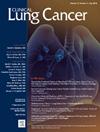Clinical, Dosimetric and Radiomic Features Predictive of Lung Toxicity After (Chemo)Radiotherapy
IF 3.3
3区 医学
Q2 ONCOLOGY
引用次数: 0
Abstract
Background
Treatment of locally advanced non small cell lung cancer (LA-NSCLC) is based on (chemo)radiotherapy, which may cause acute lung toxicity: radiation pneumonitis (RP). Its frequency seems to increase by the use of adjuvant durvalumab therapy.
Aims
To identify clinical, dosimetric, and radiomic factors associated with grade (G)≥2 RP and build a prediction model based on selected parameters.
Patients and Methods
This is a retrospective multicenter cohort study including patients receiving radiation therapy between 2015 and 2019 for LA-NSCLC. Baseline computed tomography scanners were segmented to extract radiomic features from the "Lung - Tumor" volume. Variables associated with the risk of G≥2 RP in the descriptive analysis were then selected for explanatory analysis, followed by predictive analysis.
Results
153 patients were included in 4 centers (51 with G≥2 RP). Factors associated with G≥2 RP included a high initial hemoglobin level, dosimetric factors (mean dose to healthy lungs, lung V20Gy and V13Gy), the addition of maintenance durvalumab, and 7 radiomic features (intensity distribution and texture). Other factors were associated with an increased risk of G≥2 RP in our explanatory model, such as older age, low Tiffeneau ratio, and a decreased initial platelet count. The best-performing predictive model was a random forest-based learning model using clinical, dosimetric, and radiomic variables, with an area under the ROC curve of 0.72 (95%CI [0.63; 0.80]) versus 0.64 for models using one type of data.
Conclusion
The addition of radiomic features to clinical and dosimetric ones improves prediction of the occurrence of G≥2 RP in patients receiving radiotherapy for lung cancer.
临床、剂量学和放射学特征预测化疗后肺毒性。
背景:局部晚期非小细胞肺癌(LA-NSCLC)的治疗以(化疗)放疗为主,可引起急性肺毒性:放射性肺炎(RP)。其频率似乎随着辅助杜伐单抗治疗的使用而增加。目的:确定与(G)≥2级RP相关的临床、剂量学和放射学因素,并根据选定的参数建立预测模型。患者和方法:这是一项回顾性多中心队列研究,包括2015年至2019年接受放射治疗的LA-NSCLC患者。基线计算机断层扫描仪被分割以从“肺-肿瘤”体积中提取放射学特征。然后选择描述性分析中与G≥2 RP风险相关的变量进行解释分析,然后进行预测分析。结果:4个中心纳入153例患者(51例G≥2 RP)。与G≥2rp相关的因素包括高初始血红蛋白水平、剂量学因素(对健康肺的平均剂量、肺V20Gy和V13Gy)、添加维持性杜伐单抗和7个放射学特征(强度分布和质地)。在我们的解释模型中,其他因素与G≥2 RP的风险增加相关,如年龄较大,低蒂菲诺比和初始血小板计数降低。表现最好的预测模型是基于随机森林的学习模型,使用临床、剂量学和放射学变量,ROC曲线下面积为0.72 (95%CI [0.63;0.80]),而使用一种数据的模型为0.64。结论:在临床和剂量学特征的基础上增加放射学特征可提高肺癌放疗患者G≥2 RP发生的预测。
本文章由计算机程序翻译,如有差异,请以英文原文为准。
求助全文
约1分钟内获得全文
求助全文
来源期刊

Clinical lung cancer
医学-肿瘤学
CiteScore
7.00
自引率
2.80%
发文量
159
审稿时长
24 days
期刊介绍:
Clinical Lung Cancer is a peer-reviewed bimonthly journal that publishes original articles describing various aspects of clinical and translational research of lung cancer. Clinical Lung Cancer is devoted to articles on detection, diagnosis, prevention, and treatment of lung cancer. The main emphasis is on recent scientific developments in all areas related to lung cancer. Specific areas of interest include clinical research and mechanistic approaches; drug sensitivity and resistance; gene and antisense therapy; pathology, markers, and prognostic indicators; chemoprevention strategies; multimodality therapy; and integration of various approaches.
 求助内容:
求助内容: 应助结果提醒方式:
应助结果提醒方式:


